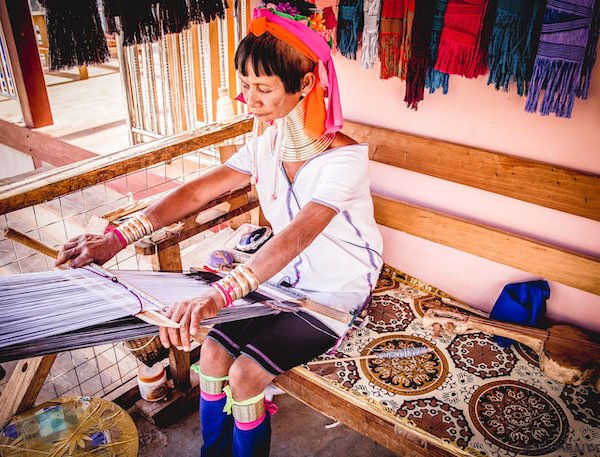Navratri day 5
This is Mu Shant. She is in her sixties. Has ten children and twenty grandchildren. Mu Shant used to live in Thailand. If you’ve ever visited the long-necked women “zoo” in Thailand you’ll know that a big portion of this Kayan tribe is still there.
The Kayan women, for centuries, have worn brass rings around their necks, to beautify their appearance, a highly uncomfortable form of jewelry, which renders their neck muscles weak. The tribe is originally from Myanmar but they fled to Thailand and obtained refugee status during the Civil War. They aren’t allowed to travel to the rest of Thailand and find themselves captive in the little village of Huai Sua Tao to entertain tourists with photographs in exchange for which they are provided with accommodation and food.
Some of them managed to leave Thailand and return to their homeland of the Loikaw village in Myanmar. Mu Shant was one of those survivors/warriors! She now makes scarves, blankets, shirts and scarves to feed her family (her husband passed away) and have created their own little village for visitors and tourists where they sell goods, show off their neck rings (the children even wear fake brass rings around their necks, denoting that the tribe is now free from the old tradition of making their women wear brass rings for life to make them look beautiful). These women are true warriors and victors of the patriarchal system and are creating a beautiful life for themselves. I love their story so much. It’s truly the power of the feminine which uses her smarts to get by rather than force and power. (Especially with having their little girls continue to wear brass rings that are removable, to continue entertaining tourists and making money, while not hiding the fact that they no longer follow the antiquated system.)
I share their story on Day 5, the day of Skandamata, the fifth manifestation of Goddess Durga. SHE is three-eyed, four-armed, and rides on a lion. Fearlessness and Power.
In the words of Sri Sri Ravi Shankar, "It is said that the Devi represents the confluence of Iccha Shakti (power of intention), Jnana Shakti (power of knowledge) and Kriya Shakti (power of righteous action). When the Shiva Tattva unites with these three powers, then what emerges is Skanda. Skandamata represents the very origin of Jnana (knowledge) and Kriya (the principle of action or activity). It can be understood as knowledge in action or action driven by right knowledge.
